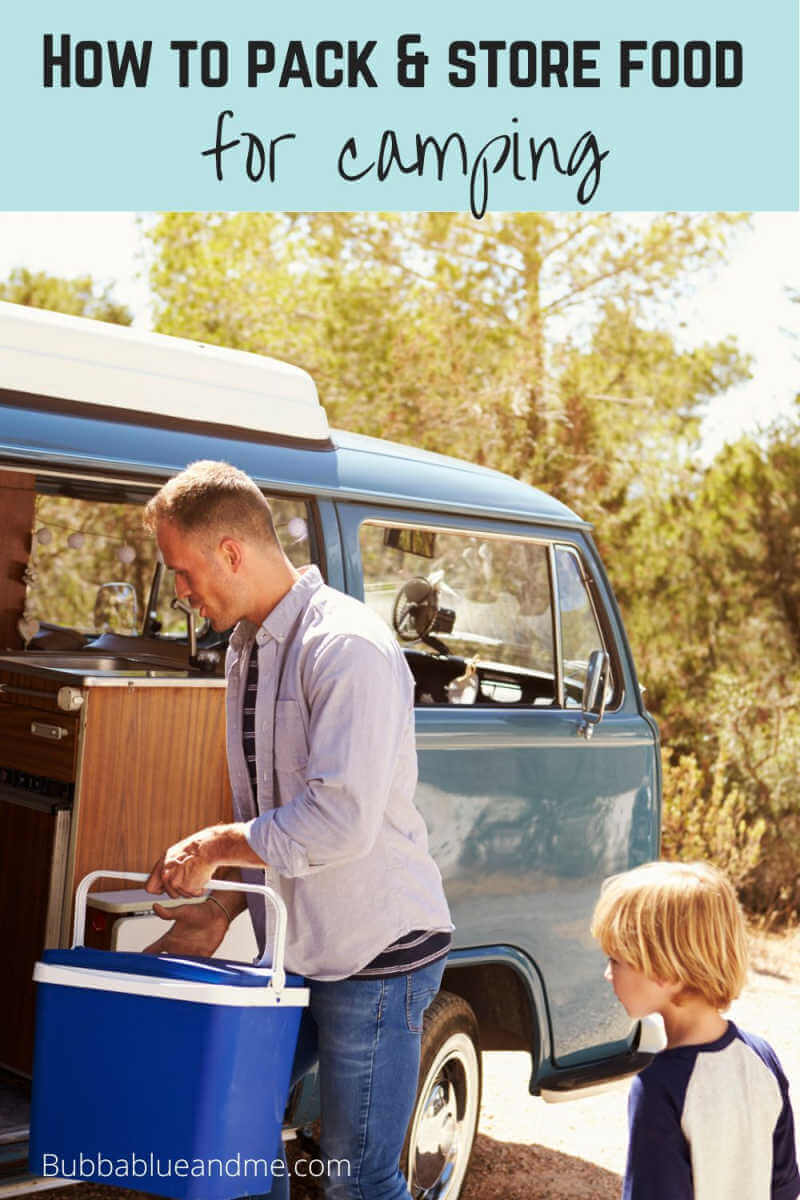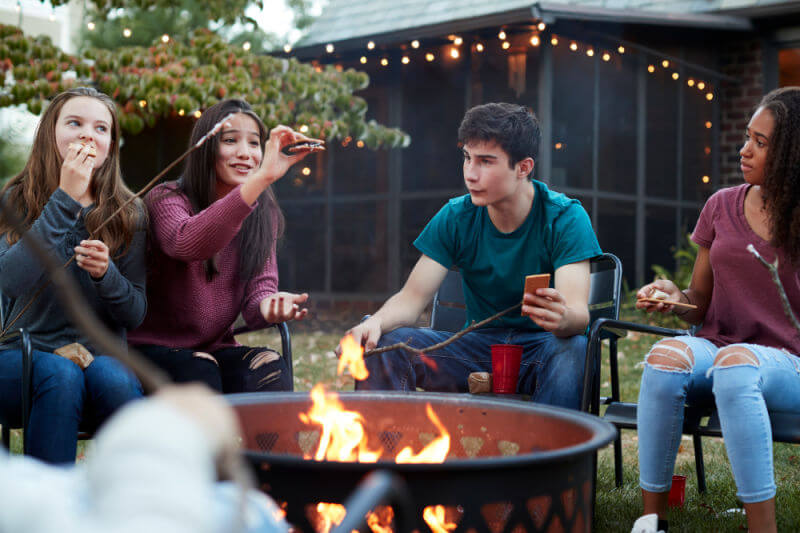How to pack food for camping and camping food storage tips
One of the key things people worry about when going camping is what to take food wise and how to store it. The solution will vary depending on what type of camping you’re doing and what season. I’ll share my tips on how to pack food for camping, and food storage tips.
My experience and tips will largely be focused on car camping, as that’s what we do most often. Hopefully there’ll be tips that can be used for other types of camping too.

When considering what food to take with you camping, don’t forget to think about the following.
1. Storage – do you have a cool box, electric or ice packs (and place to get more ice from if not using electric)?
2. Do you have food shops nearby? If not, you might need to ensure you’ve got dehydrated meals with you to avoid having to travel further everytime you need to stock up. They’re pricy, but can be useful on occasion.
3. What’s the weather going to be like? Avoid chocolate or anything that will melt in hot weather. If it’s going to be wet weather you need to know you’ll have shelter to cook under (a tarp is a handy item to create a roof you can cook under) and that you have food that’s fast to cook
4. Cooking facilities. Are you cooking on a single ring stove, campfire, BBQ or do you have several options to use. This will impact what food you bring.
5. Travel method. If you’re going by car, you’ll have more space to take food with you. If not, either shop for food once you arrive, or some places will let you get a food delivery to the campsite. Just make sure if doing that, you don’t buy too much for the cool box you have.
7. Think multiple uses. You can bring a whole made up meal (I tend to do this for the first and/or second night – freezing a chilli into 2 containers, it’ll help keep other food cool on the journey, but be defrosted by when you want to eat). But if not, think about ingredients that can be used for several meals.
How to pack food for camping
Always plan your food
If you know how many meals a day, and an idea of what you’ll be eating, you’ll not over or under pack for what you need.
I’m terrible at remembering what I need, so I always write a list for food as well as camping equipment and clothes needed.
Think about your storage
How much can you take with you, how long will it last.
Try and avoid packing more than you need. If you’re car camping, even with a list, you often find you add in extra things that may or not get used. You can always nip to a shop easily in many cases, so you don’t need all the extra just in case items.
Prep before you go
This saves time and effort. When camping, especially with children, you want to be able to just start cooking and not have it take ages to prep while you’re there. You can peel and chop veg ahead of time, marinate meats, and why not make snacks to take with you. Freeze meat before going too, so it’ll last longer. And double wrap raw meat to avoid it contaminating other food.
Make and freeze homemade ready meals
If you’re car camping, you can also take homemade ready meals with you – freeze them after cooking at home, then they’ll be gradually defrosted ready to heat up without any further prep. They’ll also act as ice packs for the other food in your coolbox.
Decant and split packs into what you need
There’s no point taking huge packs of meat or veg, large boxes of cereals. Split packs into the size you need. While plastic bags aren’t as good for the environment, if you’re camping you don’t want loads of tubs and containers that take up more room. So use sandwich or ziplock bags (you might be able to find suitable reusable bags to use). Use small pots for condiments, sugar, salt and pepper (old herbs and spices jars can be useful for these) or travel shampoo bottles for washing up liquid.
It’s also handy to collect sachets of sauces, salt, sugar, coffee etc from hotels or fast food places you go to. They’re great for camping as they’re small to fit in packing.
Keep dry and chilled foods separate
You don’t want the chilled foods making the dry boxes soggy.
Cool your coolbox first
Put some ice packs or ice in to drop the temperature before you put the food in. Then the food is moving from the fridge into a properly cold coolbox.
Pack by organising by need and storage
Keep any snacks you need for the journey separate in one bag. Then pack foods according to when you’ll eat it. As we have an electric coolbox we tend to put all our chilled food straight into that and it’s on for the journey in the car. Non perishable foods can be stored in one plastic box (lidded), and then cooking equipment in another bag or box. (Apart from fragile items like eggs, some fruit and veg), put the food you’ll eat last in the bottom, and layer up until you’ve got the current day’s food on top.
Use frozen drinks and meals as ice packs
If you’re taking water with you, freeze your water beforehand, then use in your coolbox. The same with your frozen ready meals.

Food storage while camping
Refrigeration
We don’t camp without electric hook up anymore, although using ice packs is fine. Most campsites charge for you to borrow ice packs from them. You swap your used one for a frozen one and pay each time you swap. You will need to watch out for soggy cardboard and packets because cool boxes, however good they are, will often end up with a bit of water from condensation due to opening and closing of the lid.
Top tip – if you’ve got ice pack access and want cold drinks, take a second coolbox just for drinks. It avoids the food coolbox being opened frequently.
If you don’t have a coolbox, most things will be fine for 1-2 days without being chilled. But after that you’ll need to shop regularly to pick up fresh chilled things like milk, and cheese. Otherwise you’ll be relying on long life milk that doesn’t need refrigerating and ambient foods.
Of course, if you’re camping in cold weather, then food will last longer. Not many people are hardy enough to camp outside of summer – I’ve camped in February in my young and ‘didn’t really think about the time of year’ days. Camping in the cold wasn’t fun.
Keep your cool box cold by packing all the spaces with more frozen items. Easier said than done at the start of your trip, but more ice packs or using frozen drinks will help make it more efficient and stay colder.
Plastic boxes with lids
All food should be packed away in lockable plastic boxes to ensure animals can’t access them. You might think you’ve hidden away food, but if there’s wildlife around they’ll find it. That includes rubbish bags. Make sure they’re either shut well inside your tent, but preferably throw them in the bins before you go to bed. Where we go camping, it’s usually near the coast, and the seagulls know that bin bags might mean food. We’ve heard rustling in the early morning, and found bags slightly outside a tent have been dragged out and attacked by birds.
You can lock food back in your car too, but that’s frustrating if you have to keep moving it in and out, or want to use your car in the day. In the summer, cars get really hot too, which isn’t great for keeping food in.
In the UK we don’t have to worry about bears thankfully, but if you’re camping in the US, find out about bear boxes or canisters, or what is recommended over there.
Keep your food out of the sun
Remember the shade moves with the time of day. You can use a tarp or reflective blanket over your cool box and storage to avoid it getting too warm.
Hopefully these tips will help you on your camping trip, and keep your food safe and lasting until you want to eat it.
If you want to avoid all the hassle, you can just eat out or have takeaway. But that does remove some of the fun of camping as well as costing more.
Let me know if you do things differently when you pack food for camping.
Like this post, try these other tips for nearby days out.



